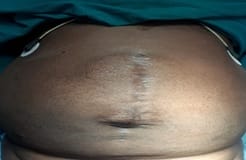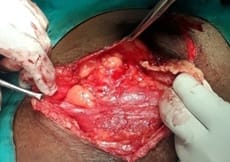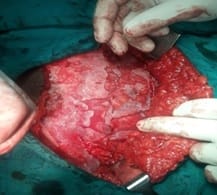Study of incisional hernia with onlay mesh repair
Khan R.1*, Singh K.2
DOI: https://doi.org/10.17511/ijoso.2020.i03.06
1* Rafat Khan, Resident, Department of General Surgery, Peoples College of Medical Sciences and Research Centre, Bhopal, Madhya Pradesh, India.
2 Kulwant Singh, Associate Professor, Department of General Surgery, Peoples College of Medical Sciences and Research Centre, Bhopal, Madhya Pradesh, India.
Background: Any abdominal wall gap with or without a bulge in the area of a postoperative scar perceptible or palpable by clinical examination or imaging is defined as an incisional hernia. The present work was thus planned to study an incisional hernia and to evaluate the outcome of onlay mesh repair with reference to a technical difficulty, complication rate, and recurrence. Methods: The study was conducted on all patients of primary incisional hernia above 18 years with the previous history of abdominal surgery and admitted for the treatment of an incisional hernia from November 2017 to April 2019. Results: Majority of patients are in a group of 51-60 years, youngest was 22 year and oldest was 69 year with a mean age of 48.6 years, with female to male ratio 5:3, most common symptom was swelling in the abdomen, 44% with irreducible swelling while 56% with reducible swelling in the abdomen, 75% with lower and 25% with upper abdomen swelling, about 6% with incisional hernia between 1-2 years of previous surgery, total 94% after 2 years of previous surgery, 44% of incisional hernias occurred below the umbilicus in the midline. Laparotomy was the most common surgery causing hernia followed by LSCS, 63% patient had hernia defect of size 1-5cm, 31% had 5-10cm, and the remaining 6% had more than 10 cm. Conclusion: For a short learning period for surgeons, the Onlay technique is a simple and effective repair, complications, and recurrence rates show to be apparently safe and require minor tissue dissection with an easy approach to the hernia repair.
Keywords: Incisional hernia, Onlay mesh, Complications, Recurrence
| Corresponding Author | How to Cite this Article | To Browse |
|---|---|---|
| , Resident, Department of General Surgery, Peoples College of Medical Sciences & Research Centre, Bhopal, Madhya Pradesh, India. Email: |
Khan R, Singh K. Study of incisional hernia with onlay mesh repair. Surgical Rev Int J Surg Trauma Orthoped. 2020;6(3):173-180. Available From https://surgical.medresearch.in/index.php/ijoso/article/view/187 |


 ©
© 

